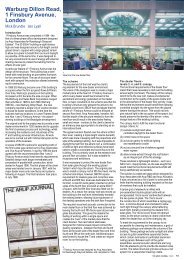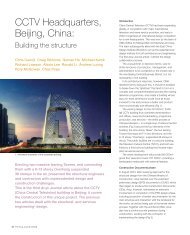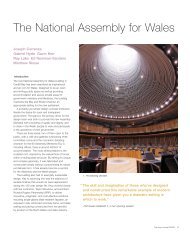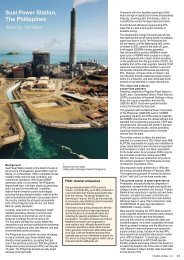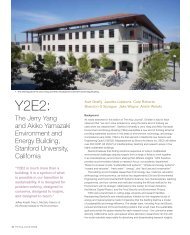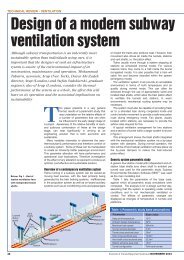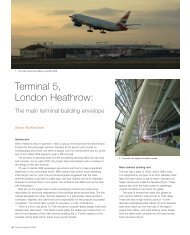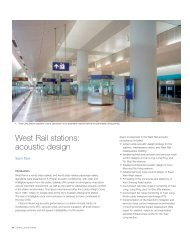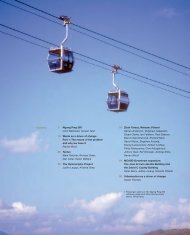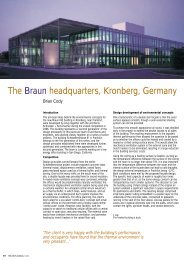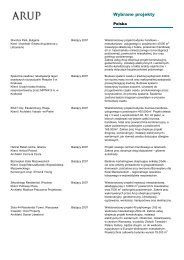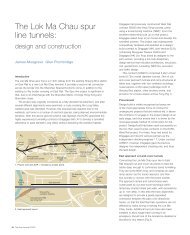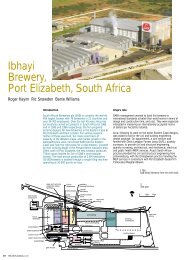Advanced Technology and Research - Arup
Advanced Technology and Research - Arup
Advanced Technology and Research - Arup
Create successful ePaper yourself
Turn your PDF publications into a flip-book with our unique Google optimized e-Paper software.
<strong>Advanced</strong> <strong>Technology</strong><br />
<strong>and</strong> <strong>Research</strong><br />
Insight | Innovation | Integration
2<br />
Introduction<br />
I am delighted to introduce <strong>Arup</strong>’s <strong>Advanced</strong><br />
<strong>Technology</strong> <strong>and</strong> <strong>Research</strong> practice brochure.<br />
AT+R provides a wide range of services to many<br />
clients, within <strong>and</strong> outside <strong>Arup</strong>, in different market<br />
sectors, <strong>and</strong> I hope that the following pages give a<br />
flavour of the diversity of our skills <strong>and</strong> the innovative<br />
<strong>and</strong> value-focused nature of our work.<br />
It is an exciting time for the Practice, one of change<br />
<strong>and</strong> growth. Whilst most of our 100 staff are<br />
currently based in the UK, we are now working<br />
towards a truly global operation, doubling in size in<br />
five years <strong>and</strong> having substantial presence in<br />
Europe, the Americas, Asia <strong>and</strong> Australasia.<br />
We are always looking for new opportunities to<br />
apply our skills <strong>and</strong> experience to our clients’<br />
benefit. Please contact me, or any of the leaders<br />
of our activities, if we can assist you in any way.<br />
Michael Willford<br />
<strong>Arup</strong> Fellow<br />
Global Leader<br />
<strong>Arup</strong> <strong>Advanced</strong> <strong>Technology</strong> <strong>and</strong> <strong>Research</strong><br />
E. michael.willford@arup.com
Contents<br />
Creating Exceptional Value p.4<br />
Design for Dynamic <strong>and</strong><br />
Environmental Loads<br />
Wind Engineering p.8<br />
Vibration Engineering p.9<br />
Seismic Engineering p.10<br />
Damping Systems p.11<br />
Case studies p.12<br />
Design of Structural <strong>and</strong><br />
Mechanical Systems<br />
Movable Structures p.20<br />
Nuclear Packaging <strong>and</strong> Transportation p.21<br />
Systems Engineering p.22<br />
Case studies p.23<br />
Future Transportation<br />
Sustainable Mobility p.30<br />
Product Development p.31<br />
Vehicle Performance Simulation p.32<br />
Case studies p.33<br />
Analysis-Led Design<br />
Offshore Engineering p.38<br />
Buildings <strong>and</strong> Infrastructure Design p.39<br />
Blast <strong>and</strong> Impact Engineering p.40<br />
Value Engineering <strong>and</strong> Optimisation p.41<br />
Case studies p.42<br />
Building Performance <strong>and</strong> Systems<br />
Building Performance p.48<br />
Building Control Systems p.49<br />
Commissioning Consultancy p.50<br />
Mechanical <strong>and</strong> Electrical Engineering p.51<br />
Case studies p.52<br />
Specialist Structural Engineering<br />
Structural Development <strong>and</strong> Support p.58<br />
Rehabilitation of Existing Structures p.59<br />
Forensic Engineering p.60<br />
Case studies p.61<br />
Software Development<br />
Numerical Methods Development p.66<br />
Oasys LS-DYNA Environment p.67<br />
Case studies p.69<br />
<strong>Research</strong>, Skills <strong>and</strong><br />
Knowledge Management<br />
<strong>Research</strong> <strong>and</strong> Development Services p.72<br />
Knowledge Management p.73<br />
Skills Network Strategy p.75<br />
Case studies p.76<br />
Cover image: GLA Building, London – Pedestrian Ramp<br />
3
4<br />
Creating<br />
Exceptional Value<br />
<strong>Arup</strong>’s <strong>Advanced</strong> <strong>Technology</strong> <strong>and</strong> <strong>Research</strong> (AT+R)<br />
practice specialises in the development<br />
of innovative, practical <strong>and</strong> cost-effective solutions<br />
to complex engineering problems, <strong>and</strong> consistently<br />
creates exceptional value for clients.<br />
We work for a wide range of clients in the buildings,<br />
bridges, civil engineering, automotive, railway, nuclear<br />
energy, petrochemical, power generation <strong>and</strong><br />
industrial sectors. We continually challenge ourselves<br />
to explore new horizons <strong>and</strong> seek better solutions<br />
through insight, innovation <strong>and</strong> integration.<br />
“The expertise <strong>and</strong> service that <strong>Arup</strong>’s <strong>Advanced</strong><br />
<strong>Technology</strong> <strong>and</strong> <strong>Research</strong> provided was of the<br />
highest value, <strong>and</strong> contributed measurably to<br />
the success of this l<strong>and</strong>mark project.”<br />
Mike Glover, Technical Director,<br />
Channel Tunnel Rail Link (High Speed 1)<br />
<strong>Arup</strong> is a global design <strong>and</strong> business consulting<br />
firm. Outst<strong>and</strong>ing solutions, innovation <strong>and</strong><br />
value characterise our work. Delivered by 10,000<br />
staff based in 90 offices around the world, our<br />
services are available to clients singly or in<br />
combination, to suit their needs.<br />
Insight: experts on call<br />
All our staff are of the highest technical calibre.<br />
The senior members of our team are world class<br />
experts in their fields, <strong>and</strong> work closely with leading<br />
academics <strong>and</strong> practitioners around the world to<br />
push forward design practice. Our experience is<br />
broad <strong>and</strong> practical, gained from the many real<br />
projects <strong>and</strong> problems on which we work. This<br />
means we are ideally placed to offer both strategic<br />
<strong>and</strong> detailed technical advice.<br />
Whilst most of our 100 staff are currently based in<br />
the UK we are in the process of forming strongly<br />
networked centres around the world to serve<br />
clients locally. For any project, our global expertise<br />
<strong>and</strong> experience are just a phone call or email away.
Innovation: research, analysis, design <strong>and</strong><br />
technical leadership<br />
We are a centre of expertise, research <strong>and</strong><br />
innovation <strong>and</strong> we play an important role in the<br />
technical leadership of <strong>Arup</strong> as a whole.<br />
We generate value through developing <strong>and</strong><br />
applying innovative concepts, alternative design<br />
strategies <strong>and</strong> advanced numerical optimisation<br />
techniques. <strong>Advanced</strong> analysis is central to our<br />
work. It is an approach we have used on many<br />
prestigious projects in recent years – a few of<br />
which are illustrated in this brochure.<br />
Integration: creative, holistic <strong>and</strong> practical<br />
The ability of our staff to look at the overall<br />
picture often leads to the emergence of improved,<br />
holistic <strong>and</strong> practical solutions. These creative<br />
breakthroughs can result in exceptional value to<br />
a project. We work both directly with clients <strong>and</strong><br />
in partnership with other <strong>Arup</strong> Groups. Our<br />
collaboration may range from a purely advisory<br />
role to the delivery of a major package of design<br />
within the context of larger projects.<br />
5
6<br />
Wind Engineering<br />
Contact:<br />
Andrew Allsop<br />
T. +44 (0)20 7755 2285<br />
E. <strong>and</strong>rew.allsop@arup.com<br />
Vibration Engineering<br />
Contact:<br />
James Hargreaves<br />
T. +44 (0)121 213 3340<br />
E. james.hargreaves@arup.com<br />
Mark Arkinstall<br />
T. +61 (0)2 9320 9509<br />
E. mark.arkinstall@arup.com<br />
Seismic Engineering<br />
Contact:<br />
Xiaonian Duan<br />
T. +44 (0)20 7755 4234<br />
E. xiaonian.duan@arup.com<br />
Michael Willford<br />
T. +44 (0)20 7755 2224<br />
E. michael.willford@arup.com<br />
Damping Systems<br />
Contact:<br />
Rob Smith<br />
T. +44 (0)20 7755 3001<br />
E. rob-j.smith@arup.com
Design for Dynamic<br />
<strong>and</strong> Environmental Loads<br />
The performance of modern structures under dynamic actions<br />
is often a major design consideration. The actions may be<br />
natural (wind, earthquake), or man-made (machinery, road or<br />
rail vehicles, human activity etc.). Engineers’ ability to design<br />
effective solutions for these effects has increased greatly in the<br />
last 30 years, <strong>and</strong> the <strong>Advanced</strong> <strong>Technology</strong> <strong>and</strong> <strong>Research</strong> team<br />
is at the forefront of international expertise.<br />
7
© BAA Plc<br />
8<br />
1<br />
2<br />
1 Manchester Stadium<br />
- roof structural loading <strong>and</strong><br />
dynamic response<br />
2 New Heathrow Visual<br />
Control Tower - structural<br />
dynamic loads, cable<br />
dynamics, active control design<br />
3 Wind environment <strong>and</strong><br />
structural loading for the<br />
Pinnacle, London<br />
© Cityscape Digital Ltd/KPF<br />
Wind Engineering<br />
AT+R provides wind engineering services to architects,<br />
planners, developers, industrial clients <strong>and</strong> design<br />
engineers at all stages of a project, including:<br />
• wind climate assessment<br />
• wind flow around buildings (for environmental<br />
impact, mechanical <strong>and</strong> natural ventilation design)<br />
• structural loading<br />
• wind-induced dynamic response<br />
• human tolerance of wind-induced motions<br />
Our in-depth knowledge of all the major wind tunnel<br />
laboratories <strong>and</strong> simulation techniques available<br />
enables us to select the most appropriate prediction<br />
methods at each stage of a project.<br />
“AT+R presented a completely new way of<br />
approaching the wind <strong>and</strong> structural design for<br />
a significant high rise tower we are working on<br />
together. This innovative approach has opened<br />
up creative possibilities while enhancing the tower’s<br />
efficiency. We are delighted to be working with the<br />
<strong>Arup</strong> team as we advance the project.”<br />
William Chilton AIA, Pickard Chilton Architects,<br />
New Haven, Connecticut<br />
3
1<br />
2<br />
3<br />
4<br />
Vibration Engineering<br />
We predict, measure, assess <strong>and</strong> control vibration<br />
in buildings, bridges, vehicles <strong>and</strong> industrial <strong>and</strong><br />
manufacturing facilities. We advise on appropriate<br />
vibration tolerance criteria for different situations, <strong>and</strong><br />
we design economic structures to meet these limits,<br />
incorporating vibration mitigation devices such as<br />
isolators, dampers <strong>and</strong> high-loss materials.<br />
Recognising the limitations of many traditional<br />
calculation techniques, we have developed, validated<br />
<strong>and</strong> published improved prediction methods for<br />
vibration due to human activities <strong>and</strong> railway traffic.<br />
These enable us to design with greater reliability - <strong>and</strong><br />
their use often leads to cost reductions.<br />
1 Modal testing of<br />
vehicles<br />
2 Vibration design for<br />
feature staircases<br />
3 Design of vibration<br />
isolation systems for<br />
Ludgate development<br />
over railway line<br />
4 Electricity Transmission<br />
Gantries - Vibration<br />
Investigation<br />
5 Pedestrian tests to<br />
validate performance of<br />
damped ramp in the GLA<br />
Building, London<br />
5<br />
9
10<br />
Seismic Engineering<br />
We are recognised leaders in performance-based<br />
seismic design for buildings, bridges, industrial,<br />
petrochemical <strong>and</strong> offshore facilities around the world.<br />
Using our advanced numerical simulation tools we<br />
take a holistic approach to the assessment of<br />
seismic performance – for example by examining the<br />
non-linear dynamic response of a structure <strong>and</strong> its<br />
foundation together.<br />
When it is cost-effective we incorporate modern<br />
seismic protection technology such as base isolators<br />
<strong>and</strong> energy absorbing devices into our designs to<br />
reduce the risk of damage <strong>and</strong> business downtime.<br />
And by exploring innovative design concepts, we<br />
unlock substantial project cost savings.<br />
Through our reputation we have been engaged to<br />
write several state-of-the-art guidance documents on<br />
industry best practice for seismic design.<br />
“This is an excellent document, very well-written,<br />
comprehensive <strong>and</strong> clear, <strong>and</strong> should serve as a<br />
solid basis for an LNG tank seismic design<br />
guideline.”<br />
Steven Wu, ExxonMobil, Houston<br />
1 Non-linear 3-D<br />
analysis model for<br />
fluid-structure-<br />
foundation analysis<br />
of LNG tank<br />
2 26 Storey<br />
Osaka International<br />
Convention Centre,<br />
Japan, incorporating<br />
unbonded braces<br />
3 Sual Power Station<br />
Philippines; design of<br />
jetty, chimney, boiler<br />
support structure <strong>and</strong><br />
ancillary buildings<br />
© Stevenson, Kinder & Scott<br />
3<br />
© OICC Consortium<br />
1<br />
2
2<br />
1<br />
3<br />
Damping Systems<br />
Dynamic response is a critical aspect of the behaviour<br />
of modern lightweight structures, <strong>and</strong> incorporating<br />
supplemental damping can be a highly cost-effective<br />
design option.<br />
We design <strong>and</strong> commission dampers for floors,<br />
footbridges, high-rise buildings, slender spires <strong>and</strong><br />
observation towers. We have expertise in tuned mass<br />
<strong>and</strong> tuned liquid dampers, visco-elastic <strong>and</strong> fluidviscous<br />
dampers <strong>and</strong> active control systems. We have<br />
also developed a number of new systems, for which<br />
patents are pending, to deliver more cost-effective<br />
solutions than conventional approaches.<br />
1 Lateral tuned<br />
mass damper for Edinburgh<br />
Airport<br />
Visual Control Tower<br />
2 Resotec - A product<br />
we developed with Richard<br />
Lees Steel Decking to<br />
damp composite floors<br />
3 <strong>Arup</strong> Damped Outrigger<br />
System<br />
(patents pending)<br />
11
© Graham Gaunt<br />
12<br />
© Graham Gaunt<br />
Case study<br />
London Millennium<br />
Footbridge<br />
Stopping the bridge from wobbling<br />
Following the excessive lateral vibrations<br />
witnessed on the London Millennium Bridge on<br />
its opening day, <strong>Arup</strong> commissioned extensive<br />
research to quantify the lateral <strong>and</strong> vertical<br />
dynamic loading due to crowds of pedestrians on<br />
bridges <strong>and</strong> developed design measures to<br />
suppress the vibration.<br />
AT+R developed the design solution that<br />
generates a high level of damping by<br />
incorporating a system of high-precision fluidviscous<br />
dampers connected to braces beneath<br />
the deck. This solution has negligible visual<br />
impact <strong>and</strong> low weight. We proved <strong>and</strong> optimised<br />
this innovative concept by extensive numerical<br />
simulation. A number of tuned mass dampers<br />
were also installed as a precaution against<br />
vertical response.<br />
A test involving three crossings of the bridge by a<br />
crowd of 2,000 pedestrians in January 2002<br />
proved the efficacy of the damping system. The<br />
level of sway was negligible even with the highest<br />
practicable crowd density.
© Patrick S McCafferty<br />
Case study<br />
US Airforce<br />
Memorial,<br />
Washington DC<br />
Maintenance-free dampers prevent<br />
wind-induced fatigue<br />
We took a key part in the design of the award<br />
winning US Airforce Memorial sculpture located<br />
next to the Pentagon in Washington DC. <strong>Arup</strong> New<br />
York was the overall lead Structural Engineer. The<br />
sculpture comprises three 80m high curved<br />
stainless steel spires of triangular cross section,<br />
reflecting a ‘star burst’ manoeuvre.<br />
AT+R conducted the wind engineering assessment<br />
<strong>and</strong> determined that the triangular sectioned spires<br />
were susceptible to ‘galloping’ at high wind<br />
speeds, likely to lead to fatigue failure. We<br />
recommended that a damping system be<br />
developed to suppress the tendency to gallop,<br />
which we then designed. The inaccessibility of the<br />
tops of the spires required a pre-installed <strong>and</strong> zero<br />
maintenance system. This, together with the very<br />
small spaces available, led us to design a ball-in-<br />
box impact damper system. Prototype tests were<br />
successful <strong>and</strong> the system was installed on all<br />
three spires.<br />
13
© Shouya Katsuta<br />
14<br />
Numerical simulation<br />
model of uplifting<br />
column base system<br />
Case study<br />
Maison Hermes,<br />
Tokyo<br />
Saving US$1million on steel <strong>and</strong><br />
foundation work in Tokyo<br />
The prestigious Maison Hermes, a slender<br />
13 storey building for Hermes Japan, by architect<br />
Renzo Piano, occupies a narrow plot less than<br />
12m wide in a highly seismic city.<br />
A conventional steel frame design was<br />
prohibitively heavy <strong>and</strong> expensive <strong>and</strong> a radical<br />
change to the structural concept was required.<br />
To achieve the desired building transparency,<br />
only a small zone at the rear of the building was<br />
available for the principal structural elements to<br />
resist earthquake actions.<br />
AT+R conceived a novel solution which would<br />
allow the rear columns of the seismic frame to lift<br />
off their foundations when the column base<br />
experienced tension. This innovative ‘stepping<br />
column’ enables the building to ‘rock’ to a limited<br />
degree under strong earthquake actions.<br />
The design of the system was optimised by<br />
non-linear numerical performance simulation of<br />
the building under earthquake motions, which<br />
showed that there would be negligible structural<br />
damage under even the strongest seismic events.<br />
The performance was superior to that of a<br />
conventional scheme containing three times the<br />
quantity of steel.<br />
The total savings for the client in steelwork <strong>and</strong><br />
foundation costs were in the region of US$1million<br />
compared with a conventional design.
© The Concrete Centre<br />
Case study<br />
A Design Guide<br />
for Footfall Induced<br />
Vibration of<br />
Structures<br />
AT+R’s performance based vibration method<br />
published by the Concrete Centre<br />
We have recently authored a comprehensive<br />
guide to footfall induced vibration, presenting a<br />
new <strong>and</strong> highly reliable method for evaluating the<br />
vibration induced by a pedestrians walking on<br />
floors or bridges. The method was developed by<br />
AT+R using fundamental research <strong>and</strong> has been<br />
verified by measurements taken on completed<br />
structures over a period of ten years.<br />
In conjunction with the publication of the Guide,<br />
new features have been incorporated into GSA,<br />
<strong>Arup</strong>’s structural analysis software, to implement<br />
the method in a user friendly manner.<br />
15
16<br />
Connection of fluidviscous<br />
dampers to<br />
perimeter columns
© WTIL/Shang Gr<strong>and</strong> Tower Corporation<br />
Case study<br />
St Francis<br />
Shangri-La Place,<br />
Manila<br />
Reducing construction costs<br />
by US$5million in Manila<br />
Our innovative alternative design for the twin<br />
60 storey St Francis towers, the tallest residential<br />
buildings in Philippines, saved our client in excess<br />
of US$5million in construction costs.<br />
Manila is a highly seismic region <strong>and</strong> also<br />
experiences typhoons. As a consequence, the<br />
original scheme for the buildings required large<br />
tuned mass dampers to suppress wind-induced<br />
sway motion, <strong>and</strong> the code-based seismic<br />
design required large structural members <strong>and</strong><br />
very high reinforcement quantities.<br />
Our alternative design incorporates viscous<br />
dampers connecting reinforced concrete<br />
outriggers from the central core to the perimeter<br />
columns to control the wind-induced motions.<br />
In addition, our use of performance-based<br />
seismic design (for the first time in the Philippines)<br />
permitted smaller members <strong>and</strong> much lower<br />
reinforcement densities than the code design.<br />
As a result, we were able to substantially reduce<br />
the quantities of concrete <strong>and</strong> reinforcement,<br />
saving construction cost. And because of the<br />
smaller columns <strong>and</strong> walls, <strong>and</strong> the space freed<br />
by the absence of a tuned mass damper, we<br />
were also able to increase the net floor area,<br />
increasing income potential.<br />
17
18<br />
Movable Structures<br />
Contact:<br />
John Lyle<br />
T. +44 (0)20 7755 2195<br />
E. john.lyle@arup.com<br />
Nuclear Packaging <strong>and</strong><br />
Transportation<br />
Contact:<br />
Chi-Fung Tso<br />
T. +44 (0)20 7755 2193<br />
E. chi-fung.tso@arup.com<br />
Systems Engineering<br />
Contact:<br />
Tim Armitage<br />
T. +44 (0)121 213 3311<br />
E. tim.armitage@arup.com
Design of Structural -<br />
Mechanical Systems<br />
Our team designs systems <strong>and</strong> products where integrated<br />
structural, mechanical, testing, commissioning <strong>and</strong> monitoring<br />
capabilities are key to a successful project outcome.<br />
19
20<br />
1<br />
2<br />
Movable Structures<br />
With an extensive track record in designing moving<br />
<strong>and</strong> deployable structures, AT+R integrates structural,<br />
mechanical <strong>and</strong> controls engineering to achieve<br />
functional <strong>and</strong> reliable products.<br />
We provide input at all stages of a project <strong>and</strong> advise<br />
on procurement strategy. Our portfolio includes large<br />
moving roofs <strong>and</strong> st<strong>and</strong>s for sport facilities,<br />
observation wheels, amusement rides, experimental<br />
research rigs, large telescope enclosures <strong>and</strong><br />
inflatable structures.<br />
1 Mechanical design<br />
of bogies for Stadium<br />
moving roof<br />
2 Singapore National<br />
Stadium movable roof<br />
scheme<br />
3 Inflatable roof<br />
designed using airbag<br />
simulation software<br />
3
© UKAEA<br />
© NDA<br />
1<br />
1 Demonstration of the<br />
impact performance of a<br />
500l drum waste package in<br />
a 25m drop<br />
2 Finite element model<br />
for the structural <strong>and</strong><br />
thermal analyses of the<br />
CASTOR KN12<br />
3 A prototype of the <strong>Arup</strong><br />
designed NDA 3m 3 Box for<br />
Intermediate Level Waste<br />
during fabrication<br />
3<br />
© Gesellschaft für Nuklear-Service mbH’<br />
2<br />
Nuclear Packaging<br />
<strong>and</strong> Transportation<br />
AT+R provides design, analysis, assessment <strong>and</strong><br />
licence application services for packages to store,<br />
dispose of <strong>and</strong> transport spent nuclear fuel,<br />
intermediate level waste <strong>and</strong> other radioactive<br />
materials. Drawing upon our 25 years international<br />
experience in this field we also offer high-level<br />
strategic advice.<br />
We pioneered the use of non-linear dynamic finite<br />
element analysis to simulate the structural response of<br />
radioactive material transportation packages in impact<br />
<strong>and</strong> drop accident scenarios, <strong>and</strong> we have remained<br />
at the forefront of this technology ever since.<br />
21
22<br />
1<br />
2 3<br />
Systems Engineering<br />
Our systems engineering services include mechanical<br />
<strong>and</strong> electrical systems integration, testing <strong>and</strong><br />
validation of complex systems, requirements<br />
engineering, technical investigations <strong>and</strong> product<br />
development. We deploy these in mechanical, civil<br />
<strong>and</strong> structural projects, <strong>and</strong> we have first-h<strong>and</strong><br />
experience of their application over a number of<br />
sectors <strong>and</strong> industries.<br />
Our technical investigation skills provide detailed<br />
measurement <strong>and</strong> monitoring of physical assets <strong>and</strong><br />
their operational environment. <strong>Advanced</strong> digital data<br />
acquisition, recording, analysis <strong>and</strong> reporting<br />
technologies enable us to provide statistically reliable<br />
bespoke reports within hours.<br />
1 Technical Investigations<br />
into ice formation on<br />
conductor systems <strong>and</strong><br />
testing of removal methods<br />
2 Development of train<br />
deployed high pressure<br />
water jetting systems<br />
3 Operational<br />
measurement of wheel/rail<br />
interface conditions
© Gesellschaft für Nuklear-Service mbH<br />
Case study<br />
CONSTOR Spent<br />
Nuclear Fuel Casks<br />
Analysis <strong>and</strong> testing to ensure the safety<br />
of spent fuel flasks<br />
As part of an application for a transport<br />
licence in both Germany <strong>and</strong> the US we<br />
developed a comprehensive finite element<br />
analysis programme for the CONSTOR V/TC<br />
full scale test cask.<br />
The casks were developed by Gesellschäft für<br />
Nuklear Services (GNS) to fulfil both the IAEA<br />
Transport Regulations <strong>and</strong> the requirements<br />
for long-term storage in the US <strong>and</strong> various<br />
European countries.<br />
AT+R carried out an extensive programme of<br />
finite element analysis to validate the design in<br />
drop accidents, prior to successful drop tests<br />
using a full-scale prototype. <strong>Arup</strong> presented<br />
the results on GNS’s behalf to both the<br />
German Competent Authority BAM <strong>and</strong><br />
the US Competent Authority US NRC.<br />
23
24<br />
Case study<br />
European Extremely<br />
Large Telescope<br />
Enclosing the world’s largest<br />
optical telescope<br />
We undertook the preliminary design of the<br />
enclosure systems, structure <strong>and</strong> mechanisms<br />
for the 80m rotating dome <strong>and</strong> retractable<br />
doors that will house the world’s largest optical<br />
telescope, the European Extremely Large<br />
Telescope (E-ELT).<br />
Developed over eight years by the European<br />
Organisation for Astronomical <strong>Research</strong> in the<br />
Southern Hemisphere (ESO), E-ELT is more<br />
than four times the size of current large optical<br />
telescopes <strong>and</strong> at least 100 times as powerful<br />
as the Hubble telescope. It will provide<br />
astronomers with a state of the art 42m<br />
diameter telescope which they will use to<br />
investigate the detailed characteristics of<br />
planets such as the ‘earth like’ Gliese 581 c<br />
recently discovered by ESO.<br />
E-ELT follows previous large telescope<br />
enclosure concept studies AT+R has<br />
undertaken <strong>and</strong> uses our retractable roof, wind<br />
<strong>and</strong> seismic engineering design expertise to<br />
deliver a unique movable enclosure. The sheer<br />
scale of this structure combined with the<br />
challenging environmental conditions at the<br />
high altitude site required a number of novel<br />
technical solutions.
Case study<br />
Technical Systems<br />
Development for<br />
UK Railways<br />
New <strong>Technology</strong> Evaluation<br />
Network Rail engaged AT+R to help develop<br />
<strong>and</strong> evaluate a laser rail head treatment<br />
system, which was designed to operate as<br />
a modular system integrated with an existing<br />
multi-purpose vehicle.<br />
We assisted the system’s designer <strong>and</strong> supplier<br />
with systems integration <strong>and</strong> sub-system<br />
development, whilst maintaining the role of an<br />
independent assessor of the performance of<br />
the system in its operating environment. We<br />
planned a series of validation <strong>and</strong> operational<br />
verification tests, which required the<br />
development of comprehensive safety plans,<br />
test plans <strong>and</strong> method statements.<br />
We created a rigorous testing programme,<br />
coordinated with existing priority operations<br />
<strong>and</strong> schedules, to operate <strong>and</strong> develop a<br />
complex <strong>and</strong> innovative system.<br />
25
Case study<br />
The London Eye<br />
AT+R provides key multi-disciplinary<br />
input to unique project<br />
AT+R was a major contributor to the concept <strong>and</strong><br />
design development of the London Eye project.<br />
A wide range of our skills were engaged.<br />
We provided wind engineering services <strong>and</strong><br />
conducted the buckling <strong>and</strong> non-linear dynamic<br />
analysis of the main structure. We also undertook<br />
the initial mechanical design of the hub <strong>and</strong><br />
spindle, main bearing, drive systems <strong>and</strong> capsule<br />
stability system.<br />
We later advised on the capsule procurement<br />
strategy <strong>and</strong> the selection of a manufacturer.<br />
This led to the development of the capsule<br />
prototype, boarding test procedures, <strong>and</strong><br />
supervision of the boarding test.<br />
27
28<br />
Sustainable Mobility<br />
Contact:<br />
Martin Sellen<br />
T. +44 (0)121 213 3291<br />
E. martin.sellen@arup.com<br />
Neil Ridley<br />
T. +44 (0)121 213 3322<br />
E. neil.ridley@arup.com<br />
Product Development<br />
Contact:<br />
Dick Stimpson<br />
T. +44 (0)121 213 3325<br />
E. dick.stimpson@arup.com<br />
Vehicle Performance<br />
Simulation<br />
Contact:<br />
Neil Butcher<br />
T. +44 (0)121 213 3349<br />
E. neil.butcher@arup.com
Future Transportation<br />
The context of the development of transportation systems has<br />
changed radically over the past few years. Energy consumption<br />
<strong>and</strong> CO 2 emissions are becoming the drivers of change for the<br />
transport industry. This is re-focusing the objectives both for<br />
urban planners <strong>and</strong> the vehicle design/production industry.<br />
29
30<br />
1<br />
2<br />
Sustainable Mobility<br />
AT+R develops routes to decarbonise transport <strong>and</strong><br />
reduce fuel costs for manufacturers, fleet operators,<br />
local authorities <strong>and</strong> others.<br />
We use Life Cycle Analysis to underst<strong>and</strong> the cost of<br />
carbon abatement. To do this, we link financial models<br />
with carbon <strong>and</strong> energy benefits for alternative fuels,<br />
vehicle architecture <strong>and</strong> built environment<br />
infrastructure. This provides a process by which each<br />
vehicle <strong>and</strong> fuelling option can be compared with the<br />
existing equivalent transport mode.<br />
We also work closely with <strong>Arup</strong> Transport Planning to<br />
advise developers <strong>and</strong> local authorities, helping<br />
influence vehicle choice <strong>and</strong> infrastructure change.<br />
1 Well to Wheel analysis<br />
2-3 Life Cycle Analysis<br />
using GaBi Software<br />
3
Product Development<br />
AT+R’s product development group develops business<br />
<strong>and</strong> product plans, carries out competitor<br />
benchmarking <strong>and</strong> defines design targets for new<br />
vehicles. These can be both performance based <strong>and</strong>,<br />
increasingly, environmental life-cycle based.<br />
Our experience of packaging, studio <strong>and</strong> concept<br />
engineering in the automotive industry includes<br />
involvement with cars, commercial vehicles <strong>and</strong> buses.<br />
Working at the earliest phase of a vehicle programme<br />
we aim to achieve the optimum outcome from a studio<br />
model with due regard for style, engineering <strong>and</strong><br />
manufacturing considerations.<br />
We also use this experience in other areas of design<br />
that benefit from the application of automotive<br />
design techniques to achieve cost effective <strong>and</strong><br />
robust outcomes.<br />
3<br />
1 Vehicle Packaging<br />
2 Interior concepts<br />
3 Whole Vehicle<br />
Concepts<br />
2<br />
1<br />
31
32<br />
1<br />
EuroNCAP EuroNCAP Frontal Pole Offset Impact<br />
FMVSS 301 Rear Impact<br />
EuroNCAP Frontal Offset<br />
EuroNCAP Pole Impact<br />
EuroNCAP FMVSS Pole 301 Impact Rear Impact<br />
EuroNCAP Side Impact<br />
FMVSS 301 Rear Impact<br />
EuroNCAP Frontal Offset<br />
EuroNCAP Pole Impact<br />
FMVSS 301 Rear Impact<br />
EuroNCAP Side Impact<br />
Vehicle Performance<br />
Simulation<br />
Efficient lightweight design is extremely important in<br />
the mass production market of the transport industry<br />
- for cost, performance <strong>and</strong> CO 2 emission reduction.<br />
We use highly detailed computer simulations to guide<br />
optimal design of vehicle structures to meet durability,<br />
crash performance, ride, <strong>and</strong> comfort targets.<br />
Using industry st<strong>and</strong>ard tools MSC/Nastran <strong>and</strong><br />
LS-DYNA, we work for many of the world’s major<br />
manufacturers including Ford, General Motors,<br />
Volkswagen, DaimlerChrysler, L<strong>and</strong> Rover <strong>and</strong> Jaguar.<br />
Our techniques are also applicable to the rail <strong>and</strong><br />
aerospace industries.<br />
Our experience extends beyond design to include<br />
management of prototype build <strong>and</strong> test programmes.<br />
1 Design for<br />
crashworthiness<br />
2 Truck durability<br />
(fatigue) analysis<br />
2
© 2008 Google - Map data ©2008 Tele Atlas<br />
Case study<br />
South East Scotl<strong>and</strong><br />
Transport<br />
Alternative Fuel Strategy<br />
SEStran is one of seven Regional Transport<br />
Partnerships in Scotl<strong>and</strong>. The partnership area<br />
includes eight local authorities within an area of<br />
3,180sq miles <strong>and</strong> is home to 28% of Scotl<strong>and</strong>’s<br />
population. There is a huge diversity of<br />
transportation issues, from urban congestion<br />
to rural public transport. SEStran aims to<br />
address these issues.<br />
AT+R were contracted to investigate <strong>and</strong> report<br />
on the relative benefits of alternative fuels, <strong>and</strong><br />
recommend ways forward to enable a move<br />
away from fossil fuel based diesel within the bus<br />
fleet over short, medium <strong>and</strong> long term.<br />
Key topics were:<br />
• Review existing bus fuel use <strong>and</strong> policies within<br />
the SEStran area<br />
• Review the potential for the use of alternative<br />
fuels, identifying practical supply <strong>and</strong><br />
economic/environment issues<br />
• Review the use of similar schemes to use<br />
alternative fuels in the UK <strong>and</strong> elsewhere<br />
• Identify how greater use of alternative fuels<br />
could best be developed in the SEStran area.<br />
Recommendations were made, focusing on the<br />
identified key issues <strong>and</strong> drivers of change for<br />
future sustainable transport solutions: local<br />
tailpipe emissions, Green House Gas emissions,<br />
<strong>and</strong> energy security.<br />
33
34<br />
Case study<br />
Heathrow Personal<br />
Rapid Transit (PRT)<br />
Designing crashworthy track<br />
systems at Heathrow<br />
<strong>Arup</strong> worked with <strong>Advanced</strong> Transport Systems<br />
<strong>and</strong> BAA to design the track for a pilot scheme<br />
to transport passengers from offsite car parking<br />
to Heathrow Terminal 5. The driverless pods of<br />
the Personal Rapid Transit (PRT) system use<br />
dead reckoning control with verification taken<br />
from the guideway via a laser probe.<br />
AT+R was contracted to consider the<br />
consequences of guidance system<br />
malfunctions. An initial study assessed the<br />
worst case scenarios for speed <strong>and</strong> angle of<br />
approach of the vehicle into the guide walls. This<br />
enabled the requirement for the crash protection<br />
elements - vehicle bumpers <strong>and</strong> front quarters,<br />
track kerbs, <strong>and</strong> nosings between diverging<br />
tracks to be quantified.<br />
We then designed aluminium honeycomb energy<br />
absorbing mechanisms for the diverge nosings<br />
which minimise vehicle deceleration levels in the<br />
case of a head-on impact, <strong>and</strong> yet maintain<br />
vehicle redirection capability under oblique<br />
impact. The nosings are several metres long to<br />
provide gradual deceleration for the vehicle <strong>and</strong><br />
its unbelted occupants.
Case study<br />
SuperLIGHT-CAR<br />
Building a car that’s 30% lighter<br />
We were a partner in the SuperLIGHT-CAR, a<br />
collaborative research <strong>and</strong> development project<br />
co-funded by the European Commission. The<br />
project had an ambitious objective - aiming to<br />
deliver the technologies <strong>and</strong> design concepts<br />
that would allow up to 30% weight reduction in<br />
C-class car models of the future, while<br />
respecting the very dem<strong>and</strong>ing cost restrictions<br />
of such popular models.<br />
Chosen for our extensive experience of car body<br />
design, we worked in partnership with a group of<br />
European car makers (Volkswagen, Fiat, Opel,<br />
Renault, Volvo, <strong>and</strong> DaimlerChrysler) to bring<br />
lightweight automotive technologies closer to<br />
high volume car production.<br />
SuperLIGHT-CAR adopted a multi-material<br />
philosophy. It strove to use the best material <strong>and</strong><br />
manufacturing processes in terms of weight <strong>and</strong><br />
cost minimisation, while fulfilling requirements in<br />
areas such as stiffness, crash performance,<br />
fatigue <strong>and</strong> corrosion resistance.<br />
The project met its objectives, <strong>and</strong> applying<br />
the weight reduction achievements of<br />
SuperLIGHT-CAR to production vehicles beyond<br />
2010 would result in the saving of millions of tons<br />
of fuel <strong>and</strong> carbon dioxide emissions.<br />
35
36<br />
Offshore Engineering<br />
Contact:<br />
David Gration<br />
T. +44 (0)20 7755 2221<br />
E. david.gration@arup.com<br />
Buildings <strong>and</strong><br />
Infrastructure Design<br />
Contact:<br />
Andrew Cunningham<br />
T. +44 (0)20 7755 2886<br />
E. <strong>and</strong>rew.cunningham@arup.com<br />
Blast <strong>and</strong> Impact<br />
Engineering<br />
Contact:<br />
Conrad Izatt<br />
T. +44 (0)20 7755 2244<br />
E. conrad.izatt@arup.com<br />
Value Engineering<br />
<strong>and</strong> Optimisation<br />
Contact:<br />
Daniel Powell<br />
T. +44 (0)20 7755 2319<br />
E. daniel.powell@arup.com
Analysis-Led Design<br />
Many modern structures have complex geometric forms, are<br />
influenced by non-linear material behaviour or buckling, <strong>and</strong> might<br />
have to be optimised in order to achieve a viable design.<br />
This type of structure can only be designed effectively in<br />
conjunction with detailed finite element analysis. AT+R’s team<br />
generates, analyses <strong>and</strong> interprets large scale finite element models<br />
using advanced software <strong>and</strong> visualisation tools with capabilities<br />
well beyond those available in normal design practice.<br />
Our analysis-led design capabilities have applications in most<br />
sectors in which high-performance structural solutions are required.<br />
37
38<br />
Offshore Engineering<br />
AT+R have a proven track record in the analysis <strong>and</strong><br />
assessment of offshore structures.<br />
This expertise has been developed both from working<br />
on <strong>Arup</strong> designed new-build platforms <strong>and</strong> from<br />
performing assessments <strong>and</strong> life-extension designs<br />
on existing structures originally designed by others.<br />
Our experience covers steel, concrete, or hybrid<br />
fixed platforms <strong>and</strong> FPSOs situated in oil fields<br />
throughout the world, <strong>and</strong> includes structural,<br />
foundation <strong>and</strong> mechanical assessment.<br />
This broad range of expertise coupled with our<br />
first-principles approach to engineering enables the<br />
most challenging of offshore problems to be tackled,<br />
from the best method to extend the life of an ageing<br />
platform to developing the best value solution for a<br />
platform in an earthquake prone region.<br />
“<strong>Arup</strong> are very competent, professional individuals,<br />
<strong>and</strong> exceeded BP’s expectations.”<br />
British Petroleum<br />
2<br />
1<br />
1 FE model of<br />
Dunlin Alpha<br />
2 Detailed model of<br />
FPSO Hull for Strength <strong>and</strong><br />
Fatigue Assessment
Buildings <strong>and</strong><br />
Infrastructure Design<br />
Architects are keen to exploit the new creative<br />
opportunities that modern high-strength materials <strong>and</strong><br />
construction techniques have to offer. AT+R’s<br />
capabilities in complex analysis help them to realise<br />
virtually any buildable vision safely - <strong>and</strong> as<br />
economically as possible, however complex the<br />
geometry. The experience of our team means we can<br />
tackle these complex projects in a timely <strong>and</strong> costeffective<br />
manner.<br />
Equally important is our ability to assess the true<br />
capacity of existing structures with greater accuracy<br />
<strong>and</strong> reliability than are permitted by conventional<br />
calculations. This enables us to reduce the<br />
contingencies associated with uncertainty <strong>and</strong> to<br />
design minimum cost <strong>and</strong> impact interventions.<br />
1 High Speed 1<br />
Medway Bridge<br />
2 Analysis of effect of<br />
openings in segmented<br />
underground railway<br />
tunnel for Tubelines<br />
3 Detailed FE model of<br />
Steelwork Connection<br />
2 3<br />
1<br />
39
40<br />
Blast <strong>and</strong> Impact<br />
Engineering<br />
Performance based design for blast <strong>and</strong> impact<br />
resistance is a special field requiring advanced<br />
numerical simulation. AT+R helps to deliver more<br />
reliable performance <strong>and</strong> time savings in the design<br />
process by using numerical simulation to develop<br />
<strong>and</strong> optimise designs for impact <strong>and</strong> blast<br />
resistance. We also design, manage <strong>and</strong> evaluate<br />
full-scale test programmes.<br />
We predict damage to structures from vehicle,<br />
aircraft <strong>and</strong> ship impact. And we design vehicle<br />
barriers <strong>and</strong> marine impact protection, bombresistant<br />
facades <strong>and</strong> blast walls for onshore <strong>and</strong><br />
offshore petrochemical facilities.<br />
2<br />
1<br />
3<br />
1 Post 9/11 aircraft<br />
engine impact studies<br />
into building columns<br />
2 Testing <strong>and</strong><br />
numerical simulation<br />
for ‘Gunpowder<br />
Plot’ explosion TV<br />
documentary<br />
3 UK Highways Agency<br />
– tests in support of<br />
new design guide for<br />
lamppost foundations
© Proces2<br />
1<br />
2<br />
3<br />
1 Example of a topology<br />
optimisation used in the<br />
concept design of a long<br />
span roof<br />
2 Challenging<br />
conventional seismic<br />
design assumptions saved<br />
$2million on the California<br />
Academy of Science<br />
building<br />
3 Gradient based<br />
optimisation reduced<br />
steelwork mass of<br />
office building<br />
4 Contour plot of building<br />
frame model showing<br />
area of steel sections in<br />
optimised design<br />
Value Engineering<br />
<strong>and</strong> Optimisation<br />
Improving value for our clients is one of AT+R’s key<br />
objectives <strong>and</strong> we have a significant track record in<br />
delivering multi-million dollar project savings.<br />
We improve projects by critically questioning<br />
assumptions using a performance-based philosophy<br />
both at a conceptual <strong>and</strong> practical level. We then<br />
validate <strong>and</strong> optimise value-focused alternatives by<br />
means of highly detailed numerical simulations. The<br />
thouroughness of our approach helps gaining<br />
acceptance in peer review <strong>and</strong> expert panel processes.<br />
Our numerical optimisation capabilities include shape<br />
<strong>and</strong> topology optimisation, gradient based optimisation<br />
<strong>and</strong> genetic algorithm techniques.<br />
4<br />
41
42<br />
Case study<br />
Taichung Metropolitan<br />
Opera House<br />
Practical design of complex reinforced<br />
concrete shell structure<br />
AT+R collaborated with <strong>Arup</strong>’s Buildings Group in<br />
the seismic <strong>and</strong> structural design of this iconic opera<br />
house building designed by Architect Toyo Ito. The<br />
structure is formed from continuous curved<br />
concrete shells of irregular geometry with a number<br />
of cores, planar walls <strong>and</strong> floors.<br />
The non-linear finite element analysis required for<br />
seismic design was performed using LS-DYNA.<br />
The model was built (<strong>and</strong> meshed semiautomatically)<br />
from surface geometry provided in<br />
Rhino format. AT+R developed an automated<br />
iterative reinforcement design procedure to<br />
enable the design to be optimised efficiently.<br />
Non-linear push-over <strong>and</strong> time history analyses<br />
were performed.<br />
During the project it was found that the traditional<br />
concrete design tools being used in conjunction with<br />
linear elastic analysis for the basic (non-seismic)<br />
design of this complex doubly curved RC structure<br />
were very conservative compared to the procedures<br />
we developed for use with LS-DYNA. The non-linear<br />
analysis approach was validated against<br />
experimental test results <strong>and</strong> the ACI building code,<br />
<strong>and</strong> independently reviewed at various stages by an<br />
expert panel in Taiwan.<br />
AT+R’s use of more sophisticated, non-linear<br />
analysis with first-principles shell reinforcement<br />
checking enabled the thickness of the concrete<br />
shells to be halved <strong>and</strong> the amount of reinforcement<br />
to be significantly reduced, leading to substantial<br />
cost saving <strong>and</strong> simplified construction.
Case study<br />
Hong Kong<br />
Highways<br />
Department<br />
Testing <strong>and</strong> numerical simulation to improve<br />
parapet design<br />
The Hong Kong Highways Department engaged<br />
<strong>Arup</strong> to assess the performance of three existing<br />
vehicle restraint systems <strong>and</strong> to investigate<br />
options to improve their effectiveness.<br />
We assessed several steel <strong>and</strong> aluminium<br />
parapets using component testing <strong>and</strong> full-scale<br />
vehicle crash tests.<br />
Detailed finite element models of the parapets<br />
<strong>and</strong> crash vehicle were developed <strong>and</strong> validated<br />
against the component <strong>and</strong> full-scale crash test<br />
results. These models were then used to design<br />
modifications to the barriers to improve their<br />
performance, including investigation of a greater<br />
variety of impact scenarios, some more severe<br />
than the regulatory ones.<br />
43
44<br />
Case study<br />
Bann River Masonry<br />
Arch Bridge<br />
Eliminating expensive bridge strengthening<br />
AT+R, as part of a design <strong>and</strong> build team, won the<br />
job of strengthening the multi-span masonry arch<br />
bridge carrying the A27 over the River Bann at<br />
Portadown, Northern Irel<strong>and</strong>.<br />
Although the bridge had been assessed by other<br />
consultants to be under strength, AT+R, by the use<br />
of non-linear numerical simulation, was able to<br />
prove the bridge adequate without strengthening.<br />
This appropriate use of advanced analysis<br />
techniques, which was independently validated by<br />
Category 3 check, removed the need for expensive<br />
<strong>and</strong> disruptive strengthening works.<br />
The method AT+R has developed for the<br />
assessment of masonry arch bridges uses<br />
non-linear finite element analysis to simulate the<br />
individual behaviour of, <strong>and</strong> interaction between,<br />
the components forming the structures. This<br />
method, which has been validated against full scale<br />
test, simulates: cracking <strong>and</strong> crushing of the<br />
masonry barrel, piers <strong>and</strong> abutments; non-linear<br />
behaviour of the fill material <strong>and</strong> flexibility of the pier<br />
<strong>and</strong> abutment foundations.<br />
The flexibility of this approach also allows the<br />
simulation of strengthening schemes to predict<br />
their effectiveness. Similar techniques have recently<br />
been used by AT+R to assess masonry tunnels.
Case study<br />
Cheviot Hybrid<br />
Gravity Substructure<br />
Design of non-conventional jack-up support<br />
<strong>and</strong> oil storage structure<br />
<strong>Arup</strong> performed the Front End Engineering<br />
Design (FEED) of this novel sub-sea jack-up<br />
support <strong>and</strong> oil storage structure for ATP<br />
Oil & Gas.<br />
This Hybrid Gravity Substructure (HGS)<br />
comprises of three concrete silos connected<br />
together with a steel truss. On top of each<br />
concrete silo is a steel can filled with ballast.<br />
This arrangement fulfils two primary functions:<br />
providing oil storage for the operation of the<br />
platform <strong>and</strong> generating a raised artificial seabed<br />
to enable conventional jack-up rigs to operate in<br />
deeper water.<br />
<strong>Arup</strong>’s responsibilities included structural <strong>and</strong><br />
mechanical design, geotechnical engineering,<br />
structural <strong>and</strong> hydrodynamic analysis, drafting<br />
<strong>and</strong> production of sufficient documentation<br />
such that this unusual structure could be<br />
tendered. We also liaised with the jacket <strong>and</strong><br />
topsides designers, installation contractors <strong>and</strong><br />
main fabrication contractors to develop the floatout,<br />
sea-tow, installation <strong>and</strong> decommissioning<br />
strategy for the structure.<br />
45
46<br />
Building Performance<br />
Contact:<br />
Barry Austin<br />
T. +44 (0)20 7755 3063<br />
E. barry.austin@arup.com<br />
Building Contol Systems<br />
Contact:<br />
Darren Wright<br />
T. +44 (0)20 7755 3360<br />
E. darren.wright@arup.com<br />
Commissioning Consultancy<br />
Contact:<br />
Darren Wright<br />
T. +44 (0)20 7755 3360<br />
E. darren.wright@arup.com<br />
Mechanical <strong>and</strong><br />
Electrical Engineering<br />
Contact:<br />
Alan Jefcoat<br />
T. +44 (0)20 7755 2019<br />
E. alan.jefcoat@arup.com
Building Performance<br />
<strong>and</strong> Systems<br />
The attention being paid to the operational performance of<br />
buildings is increasing rapidly. Rising energy prices, ‘green’<br />
legislation <strong>and</strong> higher expectations of occupants all provide<br />
a powerful impetus to improve the performance of both new<br />
buildings <strong>and</strong> of our existing building stock. Our team has<br />
world-class expertise based upon over 30 years of practical<br />
experience in this field.<br />
47
48<br />
Building Performance<br />
Improving the energy efficiency of buildings is a key<br />
component of recent legislation <strong>and</strong> corporate<br />
initiatives to reduce carbon dioxide emissions. We<br />
have been active in this field since the 1970s; our team<br />
has unrivalled expertise based on detailed studies <strong>and</strong><br />
surveys of numerous buildings in use.<br />
“Brilliant ideas were contributed <strong>and</strong> <strong>Arup</strong> was<br />
always proactive in inputting to the brief.’’<br />
British L<strong>and</strong><br />
“Barry’s technical input was paramount to this<br />
project <strong>and</strong> he was excellent at communicating this<br />
information in a non-technical way both to us <strong>and</strong><br />
also to the client.”<br />
<strong>Arup</strong> Environmental<br />
We provide services in strategy, research <strong>and</strong><br />
implementation. These encompass design,<br />
monitoring, operational practices, legislative<br />
compliance, <strong>and</strong> renewable energy. We use feedback<br />
from operational experience to improve the design of<br />
new buildings <strong>and</strong> the refurbishment of existing ones.<br />
1 Workplace<br />
environments affect<br />
productivity <strong>and</strong> staff<br />
satisfaction<br />
2 Energy management<br />
for British L<strong>and</strong>’s portfolio<br />
3 Identification of<br />
leakage paths on an<br />
air h<strong>and</strong>ling plant<br />
2<br />
© Peter Cook+VIEW<br />
1<br />
3
Building Control<br />
Systems<br />
We are entering the era of the truly intelligent<br />
building, providing opportunities to operate building<br />
systems with far greater flexibility <strong>and</strong> effectiveness<br />
to achieve reduced operating costs <strong>and</strong> greater<br />
occupant satisfaction.<br />
We pride ourselves on delivering system solutions<br />
which are based on industry st<strong>and</strong>ard ‘open’ protocols<br />
<strong>and</strong> are vendor independent. Whether interfacing<br />
legacy products, connecting to a client’s existing<br />
TCP/IP network, designing a complete control system<br />
or specifying a common graphic user interface (GUI)<br />
platform, we are expert in the technical <strong>and</strong><br />
commercial implications of convergence.<br />
We aim to:<br />
• deliver best of breed BMS/HVAC control solutions<br />
<strong>and</strong> to maximise inter-operable potential between<br />
all building control systems<br />
• provide independent consultancy for total<br />
project solutions<br />
• increase the availability of information through the<br />
automatic collection of data, enhancing energy<br />
analysis <strong>and</strong> business critical monitoring tools<br />
• enable more cost-effective management of facilities<br />
1 Distribution of<br />
air conditioning <strong>and</strong><br />
ventilation<br />
2 Configuration of<br />
‘Building Control Systems’<br />
network<br />
3 Smoke extract vents<br />
4 Plantroom<br />
control panel<br />
© Percy Thomas Partnership Martin Haswell<br />
2<br />
4<br />
1<br />
3<br />
49
50<br />
Commissioning<br />
Consultancy<br />
No matter how well building services are designed,<br />
a poorly commissioned building will always fall<br />
short of expectations.<br />
It is common for commissioning considerations to be<br />
addressed only at the final stage of a project when the<br />
MEP <strong>and</strong> control systems are installed. Often,<br />
commissioning managers are not involved until this<br />
stage of the works, by which time systems are fixed<br />
<strong>and</strong> cannot be changed without substantial additional<br />
investment. We have demonstrated that the<br />
appointment of a specialist Commissioning Consultant<br />
at an early stage adds value to a project by ensuring<br />
designs are both fit for purpose <strong>and</strong> can be<br />
commissioned as intended.<br />
Our team has extensive knowledge in all aspects<br />
of mechanical, electrical, public health <strong>and</strong> control<br />
systems design <strong>and</strong> commissioning. We can therefore<br />
evaluate designs at the earliest stages of a project to<br />
assess potential problems in commissioning. Also,<br />
advising timely changes to the design saves cost<br />
in respect of later design changes, programme<br />
disruption <strong>and</strong> delay.<br />
Our Commissioning Consultants work with our<br />
Building Performance team to address post<br />
occupancy issues, whether these are identified<br />
as a result of operational, maintenance, people<br />
or energy related issues.<br />
The combined strength of these services can<br />
significantly improve the operational performance<br />
of a client’s existing building, campus or portfolio.<br />
3<br />
1 Tate Modern -<br />
transformer bay<br />
2 Electrician restoring<br />
breaker panel<br />
3 Services in<br />
a new factory<br />
2<br />
© Dennis Gilbert+VIEW<br />
1
M&E Engineering<br />
We have a team of highly experienced M&E<br />
engineers dedicated to providing world-class<br />
support to building design projects throughout the<br />
<strong>Arup</strong> world, <strong>and</strong> contributing to the development of<br />
Industry Best Practice guidance. Their fields of<br />
expertise include mechanical <strong>and</strong> electrical services,<br />
natural ventilation, energy efficiency, optimum<br />
building operation <strong>and</strong> renewable technologies. From<br />
their extensive <strong>and</strong> ongoing portfolio of survey <strong>and</strong><br />
troubleshooting work in existing buildings they are<br />
able to provide improved predictions of the likely<br />
performance of buildings at the design stage, <strong>and</strong><br />
how occupants will respond within them.<br />
1 Technical advice on<br />
st<strong>and</strong>by diesel generators<br />
in data centre<br />
2 Heat metering<br />
to establish base load<br />
for CHP feasibility<br />
investigation for the<br />
British Museum<br />
3-4 Use of thermography<br />
to study building thermal<br />
performance<br />
3<br />
4<br />
1<br />
2<br />
51
© David J Osborn<br />
52<br />
Case study<br />
Chiswick Park<br />
West London<br />
Refining building design at Chiswick Park<br />
We were commissioned by property developer<br />
Stanhope PLC to examine the thermal <strong>and</strong><br />
energy performance of building number one at<br />
Chiswick Park in West London, with the aim of<br />
refining the design of future buildings on this<br />
major business park.<br />
Using our experience of monitoring buildings,<br />
we evaluated the effectiveness of the external<br />
solar shading, floor supply system, indoor air<br />
quality, small power usage, electrical heating,<br />
<strong>and</strong> fuel <strong>and</strong> power consumption.<br />
Monitoring the building while it was occupied<br />
presented a significant challenge. Access to a<br />
large selection of specialist equipment helped<br />
to ensure minimum disruption was caused to<br />
the occupants.
Wills Memorial Building,<br />
University of Bristol<br />
Case study<br />
University of Bristol<br />
Secure Data Network Project<br />
<strong>Arup</strong> was appointed to investigate <strong>and</strong><br />
develop the business case for implementation<br />
of a secure data network (SDN) to act as the<br />
common communications tool for all legacy<br />
control systems <strong>and</strong> their extensive future<br />
expansion to incorporate an ambitious capital<br />
projects programme.<br />
The project required co-ordinated working with<br />
five university stake holders (building services,<br />
capital projects, energy office, security office <strong>and</strong><br />
telephone services). Upon implementation the<br />
individual systems will utilise a common TCP/IP<br />
transport medium for distribution of data.<br />
A common graphical user interface (GUI)<br />
utalising industry st<strong>and</strong>ard open protocols, will<br />
be provided for system operator control,<br />
monitoring <strong>and</strong> alarm h<strong>and</strong>ling.<br />
Once implemented the SDN project will deliver a<br />
reduction in long term product <strong>and</strong> training costs<br />
<strong>and</strong> the automatic delivery of building services<br />
energy data for automated billing <strong>and</strong> analysis.<br />
The resilience of security, fire <strong>and</strong> critical alarm<br />
monitoring together will also be improved<br />
together with maintenance efficiencies.<br />
53
54<br />
Case study<br />
Citigroup Data Centre,<br />
Frankfurt<br />
Achieving LEED Platinum<br />
We were appointed as the Commissioning<br />
Authority for the commissioning, testing <strong>and</strong><br />
validation of Citigroup’s award winning Data<br />
Centre located on the outskirts of Frankfurt,<br />
Germany. The building was the subject of LEED<br />
Accreditation seeking Platinum status.<br />
Our consultancy role involved the formulation<br />
of a project specific Commissioning Plan <strong>and</strong><br />
produced the method statements for<br />
Commissioning, Integrated System Tests <strong>and</strong><br />
Black Building tests. During the course of the<br />
project, commissioning workshops were held<br />
with the design team <strong>and</strong> the appointed<br />
contractor, <strong>and</strong> project specific commissioning<br />
<strong>and</strong> testing sheets were produced to record all<br />
commissioning activities.<br />
Validation tests were performed prior to Practical<br />
Completion to ensure all the building services<br />
performed to the project specification<br />
requirements. Practical Completion was<br />
achieved approximately 12 months from the start<br />
of construction on site.<br />
LEED accreditation for buildings has been<br />
gaining momentum over the last few years, <strong>and</strong><br />
we have delivered our commissioning<br />
consultancy service in Europe <strong>and</strong> the USA.
1<br />
Case study<br />
Authorship of Building<br />
Services Engineers’<br />
Guides <strong>and</strong> Reports<br />
Our senior M&E experts work on code<br />
committees <strong>and</strong> regularly author industry<br />
Design Manuals.<br />
Recent examples of this work include<br />
1 CIBSE Guide H: Building Control Systems<br />
2 Carbon Trust: Technical Review of Building Fabric<br />
(Energy Performance)<br />
3 British Telecom: Cradle to Grave Guides<br />
55
56<br />
Structural Development<br />
<strong>and</strong> Support<br />
Contact:<br />
Sarah Kaethner<br />
T. +44 (0)20 7755 3663<br />
E. sarah.kaethner@arup.com<br />
Rehabilitation of Existing<br />
Structures<br />
Contact:<br />
Deborah Lazarus<br />
T. +44 (0)20 7755 3239<br />
E. deborah.lazarus@arup.com<br />
Forensic Engineering<br />
Contact:<br />
Tony Jones<br />
T. +44 (0)20 7755 2057<br />
E. tony-e.jones@arup.com
Specialist Structural<br />
Engineering<br />
The senior members of our team are world class experts in their<br />
fields, <strong>and</strong> work closely with leading academics <strong>and</strong> practitioners<br />
around the world to push forward design practice. Our experience<br />
is broad <strong>and</strong> practical, gained from the many problems <strong>and</strong> real<br />
projects on which we work. This means we’re ideally placed to offer<br />
both strategic <strong>and</strong> detailed technical advice.<br />
57
58<br />
1 1 Internal Guidance<br />
through the Structural Structural Development<br />
Skills Network<br />
<strong>and</strong> Support<br />
2<br />
2 Technical advice<br />
for International Finance<br />
Centre, 2IFC Tower,<br />
Hong Kong<br />
3 Assistance in the<br />
design of complex<br />
structures<br />
3<br />
Our team includes several of <strong>Arup</strong>’s experts in<br />
structural engineering, <strong>and</strong> AT+R hosts the leadership<br />
of the firm’s Structural Skills Network.<br />
Most of these highly experienced people also<br />
represent the firm on code <strong>and</strong> institution committees.<br />
They provide strategic input to the development of<br />
structural engineering in <strong>Arup</strong> <strong>and</strong> develop tools <strong>and</strong><br />
guidance for project engineers working on a diverse<br />
range of projects, from bridges, industrial <strong>and</strong><br />
commercial structures to historic buildings.<br />
They assist with design <strong>and</strong> research projects<br />
throughout the world, run training courses <strong>and</strong> steer<br />
the development of <strong>Arup</strong>’s structural analysis software.<br />
Areas of expertise include steel, reinforced concrete,<br />
timber, masonry, new materials <strong>and</strong> specialist<br />
structural analysis.<br />
“Developing a logical approach to analyzing <strong>and</strong><br />
designing for the tying forces on the mega-columns<br />
of the 2IFC Tower … saved the client money by a<br />
dramatic reduction in the floor design through<br />
interpretation <strong>and</strong> extension of the code.”<br />
<strong>Arup</strong>, Hong Kong
Rehabilitation of<br />
Existing Structures<br />
We coordinate all aspects of investigation, repair <strong>and</strong><br />
refurbishment of existing buildings <strong>and</strong> structures - both<br />
contemporary <strong>and</strong> historic.<br />
Our expertise in traditional construction, materials <strong>and</strong><br />
retrofit technology is coupled with state of the art<br />
analysis capabilities that enable us to develop unique<br />
<strong>and</strong> cost-effective minimum intervention solutions.<br />
“<strong>Arup</strong> recommended an alternative idea <strong>and</strong><br />
approach that neither we nor their competitors had<br />
considered …I would most certainly recommend<br />
AT+R to others, particular with regard to Listed<br />
Building projects <strong>and</strong> heritage issues.”<br />
Network Rail<br />
1 Survey of the listed Eleanor Cross<br />
Monument at Charing Cross Station<br />
for Network Rail<br />
2 Regeneration of the<br />
Crossways Estate in East London.<br />
Refurbishment of three residential<br />
tower blocks. Visual survey<br />
followed by a comprehensive<br />
programme of investigations <strong>and</strong><br />
repairs to the frame<br />
3 The Rich Mix Centre.<br />
Refurbishment of existing buildings<br />
(circa 1940’s to 1970’s). Visual survey<br />
of the precast cladding followed by<br />
investigations <strong>and</strong> recommendations<br />
for remedial works to suit the budget<br />
<strong>and</strong> intended lifespan of the building<br />
4 York Minster restoration.<br />
Following the fire in the South<br />
Transept roof of York Minster, <strong>Arup</strong><br />
provided advice on the protection<br />
<strong>and</strong> temporary works required<br />
<strong>and</strong> carried out the design of the<br />
replacement roof structure<br />
2<br />
3<br />
1<br />
© Woodmansterne Picture Library<br />
4<br />
59
60<br />
1 1-2 Numerical simulation Forensic Engineering<br />
2<br />
used to underst<strong>and</strong><br />
cable-stayed roof failure<br />
mechanism<br />
3 Studies into gauge<br />
corner cracking for<br />
Railtrack plc<br />
3<br />
Using our practical <strong>and</strong> analytical expertise we<br />
investigate failures or malfunctions of structures,<br />
mechanisms or systems in buildings <strong>and</strong> facilities.<br />
We explore cases ranging from the total collapse of<br />
major structures to serviceability issues caused by<br />
factors such as the deterioration of fabric, mechanical<br />
failure, plant malfunction <strong>and</strong> excessive vibration.<br />
Following examination we undertake design of<br />
remedial measures <strong>and</strong> support the legal process<br />
through expert witness commissions.
1<br />
3<br />
4<br />
2<br />
Case study<br />
Authorship of<br />
Structural Engineers’<br />
Design Manuals<br />
Writing structural engineers’ design manuals<br />
Our senior structural experts work on code<br />
committees <strong>and</strong> regularly author industry<br />
Design Manuals.<br />
Recent examples of this work include:<br />
1 CIRIA C579: Retention of Masonry façades best<br />
practice guide (London, 2003).<br />
Please visit: www.ciria.org / www.ciriabooks.com<br />
2 Concrete Society: Technical Report 43: Post-tensioned<br />
concrete floor design h<strong>and</strong>book (2005) ©The Concrete<br />
Society – reproduced with permission. Copies of TR43 can<br />
be purchased from www.concretebookshop.com<br />
3 American Hardwood Export Council: Structural design<br />
in American Hardwoods (2005)<br />
4 Institution of Structural Engineers: Manual for<br />
the design of concrete building structures to Eurocode 2,<br />
©IStructE<br />
“<strong>Arup</strong> AT+R are considered to provide<br />
the best technical expertise in the<br />
engineering world.”<br />
American Hardwood Export Council<br />
61
62<br />
Case study<br />
St Pancras Station<br />
Redeveloping St Pancras Station as the<br />
new terminus for High Speed 1<br />
Combining AT+R’s knowledge of both<br />
traditional building with its advanced 3D<br />
non-linear finite element analysis skills enabled<br />
a minimum intervention strengthening solution<br />
to be developed for St Pancras Station. This<br />
solution met both the rigorous constraints<br />
required by English Heritage <strong>and</strong> the tight<br />
programme needed to deliver this high-profile<br />
project on time.<br />
“As part of refurbishing St. Pancras station,<br />
Union Rail commissioned <strong>Arup</strong>’s <strong>Advanced</strong><br />
<strong>Technology</strong> <strong>and</strong> <strong>Research</strong> group to assess this<br />
heritage structure. <strong>Arup</strong> made sure they fully<br />
understood all the issues, completed a<br />
rigorous investigation to ensure a robust but<br />
not over-conservative assessment <strong>and</strong><br />
presented the results in a format clear to both<br />
a technical <strong>and</strong> non-technical audience.”<br />
David R Bennett, Implementation Director, Union<br />
Railways (North) Ltd<br />
AT+R’s responsibilities included the justification<br />
of the masonry, stone, cast iron <strong>and</strong> wrought<br />
iron structure supporting the train deck.
Case study<br />
Kerrin Point Explosion<br />
Investigating a boiler explosion<br />
The London Borough of Lambeth commissioned<br />
us to carry out a forensic investigation after an<br />
explosion in a boiler house at the base of a<br />
22-storey block of flats. Our aim was to<br />
determine the causes of the explosion <strong>and</strong> to<br />
ensure that another would not occur.<br />
AT+R led the project providing structural,<br />
mechanical, electrical <strong>and</strong> blast specialist<br />
input. Communications professionals were<br />
also involved in media relations <strong>and</strong> public<br />
consultations.<br />
Interviews with residents of the flats assisted in<br />
determining the sequence of events leading to<br />
the explosion. The team carried out<br />
mathematical analysis <strong>and</strong> led the required<br />
experiments <strong>and</strong> tests.<br />
The independent <strong>and</strong> objective assessment for<br />
the Borough included a thorough review of<br />
historic data, <strong>and</strong> interviews with key staff<br />
members to establish the previous operation <strong>and</strong><br />
maintenance of the boiler house <strong>and</strong> equipment.<br />
63
64<br />
Numerical Methods<br />
Development<br />
Contact:<br />
Richard Sturt<br />
T +44 (0)121 213 3305<br />
E. richard.sturt@arup.com<br />
Oasys LS-DYNA ® Environment<br />
Contact:<br />
Brian Walker<br />
T +44 (0)121 213 3317<br />
E. brian.walker@arup.com
Software Development<br />
<strong>Advanced</strong> numerical analysis is central to much of our work,<br />
<strong>and</strong> to keep our capabilities at the leading edge we have a<br />
team of software engineers developing new methods <strong>and</strong><br />
features for our analysis <strong>and</strong> visualisation software.<br />
65
66<br />
Numerical Methods<br />
Development<br />
We create <strong>and</strong> adapt special software tools, enabling<br />
our analysis teams to solve a precise project-specific<br />
problem without being limited by the capabilities of<br />
existing software.<br />
Our team has developed numerous new features for<br />
the non-linear finite element analysis program<br />
LS-DYNA – particularly for seismic <strong>and</strong> geotechnical<br />
analysis. We also develop bespoke st<strong>and</strong>-alone<br />
applications. For example, we developed <strong>Arup</strong>’s<br />
Discrete Vortex Method (DVM) for analysing bridge<br />
deck stability in wind <strong>and</strong> software for calculating<br />
fatigue performance of vibrating structures.<br />
2<br />
1 New seismic features<br />
for LS-DYNA<br />
a Squat reinforced<br />
concrete shear wall<br />
b Seismic Isolator<br />
c Soil<br />
d Steel Brace<br />
2 <strong>Arup</strong> DVM simulation<br />
of vortex shedding<br />
in wind<br />
1a<br />
1b<br />
1c<br />
1d
Oasys LS-DYNA ®<br />
Environment<br />
Our software team is primarily engaged with the<br />
powerful <strong>and</strong> versatile LS-DYNA finite element code<br />
developed by Livermore Software <strong>Technology</strong><br />
Corporation (LSTC). We have over twenty years of<br />
experience of working with LS-DYNA <strong>and</strong> distribute<br />
<strong>and</strong> support it commercially in the UK, India <strong>and</strong><br />
China. Our team also provides LS-DYNA to a number<br />
of <strong>Arup</strong> groups.<br />
We also develop the market-leading graphical pre- <strong>and</strong><br />
post-processing software for LS-DYNA, “Oasys<br />
LS-DYNA Environment Software”, which is sold<br />
worldwide through a network of distributors under the<br />
Oasys trade name. Users include many of the world’s<br />
largest car manufacturers as well as their suppliers<br />
<strong>and</strong> consultancies <strong>and</strong> universities.<br />
3<br />
1 Crash model set up<br />
with Oasys PRIMER<br />
2 Oasys D3PLOT used<br />
to post-process seismic<br />
response analysis<br />
3 Typical LS-DYNA<br />
occupant safety model<br />
incorporating a crash<br />
dummy<br />
4 Oasys LS-DYNA<br />
Environment Software<br />
2<br />
4<br />
1<br />
67
Image Courtesy of Jaguar Cars<br />
68<br />
Jaguar XF analysed<br />
using Oasys LS-DYNA ®<br />
Environment
Case study<br />
LS-DYNA Models of<br />
Seismic Behaviour<br />
of Reinforced Concrete<br />
Shear Walls<br />
Development <strong>and</strong> validation<br />
of state-of-the-art simulation capabilities<br />
Representing the performance of reinforced<br />
concrete structures in earthquakes by numerical<br />
simulation is a major challenge due to the inherent<br />
complexity of the material behaviour. AT+R has<br />
developed new material models for use in shell<br />
element representations of walls in LS-DYNA.<br />
The performance of the model was validated by<br />
simulation of shake table tests conducted by<br />
NUPEC in 1994. The test investigates the dynamic<br />
response of a squat (shear governed) shear wall<br />
specimen under imposed base accelerations, at<br />
levels of response ranging from fully elastic to<br />
collapse. We constructed a model of the<br />
reinforced concrete shear wall in LS-DYNA<br />
<strong>and</strong> applied the base accelerations used in<br />
he shake table test.<br />
The performance of the numerical model was<br />
examined by comparing the force versus<br />
displacement response of the top of the wall.<br />
Very good agreement was achieved with that<br />
of the test specimen.<br />
69
70<br />
<strong>Research</strong> <strong>and</strong><br />
Development Services<br />
Contact:<br />
Jennifer Schooling<br />
T. +44 (0)20 7755 2912<br />
E. jennifer.schooling@arup.com<br />
Knowledge Management<br />
Contact:<br />
Dominique Avery Poole<br />
T. +44 (0)20 7755 3065<br />
E. dominique.poole-avery@arup.com<br />
Skills Network Strategy<br />
Contact:<br />
Faith Wainwright<br />
T +44 (0)20 7755 2051<br />
E. faith.wainwright@arup.com
<strong>Research</strong>, Skills <strong>and</strong><br />
Knowledge Management<br />
AT+R hosts the <strong>Research</strong> <strong>and</strong> Development business,<br />
Skills Network strategy <strong>and</strong> Knowledge Management<br />
functions for <strong>Arup</strong>.<br />
71
72<br />
1 <strong>Research</strong> <strong>and</strong><br />
Development Services<br />
2 3<br />
<strong>Arup</strong> provides research solutions <strong>and</strong> management<br />
services integrating internal <strong>and</strong> external expertise.<br />
We use our unique combination of technical<br />
knowledge, research skills, international networks <strong>and</strong><br />
project management capability. We have relationships<br />
with many of the world’s leading research<br />
establishments over a wide range of disciplines <strong>and</strong><br />
are able to advise on funding routes <strong>and</strong> the assembly<br />
of multi-centre teams. We also assist clients in the<br />
development of <strong>Research</strong> <strong>and</strong> <strong>Technology</strong> Strategies.<br />
Areas of expertise include <strong>Research</strong> Programme<br />
Management, Sustainability, Building Design <strong>and</strong><br />
Performance, Climate Change Adaptation, Energy,<br />
Design for Human Performance, Roadmapping <strong>and</strong><br />
workshop facilitation.<br />
1 Photovoltaic<br />
panel - CIS Chief<br />
Office Service<br />
Tower Recladding,<br />
Manchester<br />
2 Delegates at the<br />
National Platform<br />
ICTA roadmapping<br />
workshop<br />
3 Delegates at a<br />
strategic roadmapping<br />
workshop
1<br />
Contents<br />
Why is knowledge sharing<br />
important to our business? . . . . . . . . . . . . . . . . . . . . . . . 4<br />
Managing knowledge to add value<br />
How do we manage<br />
information overload? . . . . . . . . . . . . . . . . . . . . . . . . . . . . . 6<br />
Knowledge br<strong>and</strong>s<br />
How do I find<br />
the right expertise? . . . . . . . . . . . . . . . . . . . . . . . . . . . . . . . 8<br />
<strong>Arup</strong> People<br />
How do we learn from<br />
project experience? . . . . . . . . . . . . . . . . . . . . . . . . . . . . . 10<br />
<strong>Arup</strong> Projects<br />
How do I avoid<br />
reinventing the wheel? . . . . . . . . . . . . . . . . . . . . . . . . . . . 12<br />
Processes<br />
How do we deliver our<br />
global expertise locally? . . . . . . . . . . . . . . . . . . . . . . . . . 14<br />
Networks<br />
How do I learn from my<br />
colleagues’ experience? . . . . . . . . . . . . . . . . . . . . . . . . . 16<br />
Discussion forums<br />
How do I recognise<br />
<strong>Arup</strong> best practice? . . . . . . . . . . . . . . . . . . . . . . . . . . . . . . 18<br />
Insight<br />
How do I ensure the<br />
delivery of quality? . . . . . . . . . . . . . . . . . . . . . . . . . . . . . . 20<br />
<strong>Arup</strong> Essentials<br />
How do we prepare<br />
for the future? . . . . . . . . . . . . . . . . . . . . . . . . . . . . . . . . . . . 22<br />
Knowledge strategy<br />
Why should I share<br />
my knowledge? . . . . . . . . . . . . . . . . . . . . . . . . . . . . . . . . . . 24<br />
Knowledge sharing is power<br />
How can I enhance bids with<br />
our knowledge track record? . . . . . . . . . . . . . . . . . . . . . 26<br />
Competitive advantage<br />
Glossary . . . . . . . . . . . . . . . . . . . . . . . . . . . . . . . . . . . . . . . . 28<br />
3<br />
9<br />
Upload a recent<br />
photograph<br />
Describe your<br />
particular skills <strong>and</strong><br />
areas of expertise<br />
List the subjects in<br />
which you have a<br />
developing interest<br />
Add your hobbies<br />
<strong>and</strong> interests<br />
Additional information<br />
eg . subjects you speak<br />
about at conferences<br />
Upload your CV<br />
Upload general<br />
references, ie . papers<br />
you’ve written, links to<br />
key websites etc .<br />
Lists communities that<br />
you are a member of<br />
Lists communities that<br />
you’ve created<br />
Knowledge<br />
Management<br />
<strong>Arup</strong> is uniquely placed to offer specialist services<br />
in Knowledge Management, given the firm’s distinct<br />
culture <strong>and</strong> approach to business. Knowledge<br />
Management is the way we share skills <strong>and</strong> experience<br />
within the firm to provide our clients with faster, more<br />
cost-effective solutions. <strong>Arup</strong>’s Knowledge<br />
Management expertise has led to leading edge<br />
solutions to business problems around the world.<br />
Our Knowledge Team is supported by a variety of<br />
specialists as required to ensure a truly customised<br />
service across a range of business sectors. We<br />
combine current knowledge of academic trends with<br />
practical underst<strong>and</strong>ing of real world solutions.<br />
<strong>Arup</strong> has been recognised in several benchmarking<br />
studies as leading the way in Knowledge Management<br />
<strong>and</strong> has received awards for its Knowledge<br />
Management approach annually since 2001.<br />
1 Knowledge H<strong>and</strong>book<br />
2 2006 Innovation in<br />
Knowledge Management<br />
Award, International<br />
Information Industry<br />
awards - Winner<br />
2<br />
73
Skills Network Strategy<br />
Networking is built into the <strong>Arup</strong> culture <strong>and</strong> is a key<br />
component of achieving innovation on projects. By<br />
provoking <strong>and</strong> facilitating cross-group technical<br />
activities in support of business objectives, <strong>Arup</strong>’s<br />
skills networks play a key role in delivering the firm’s<br />
global experience to clients locally.<br />
Our Networks are a valuable differentiator between<br />
<strong>Arup</strong> <strong>and</strong> its competitors. The role of the Network<br />
Strategy Team is to extend them to reach all parts of<br />
the firm. Our objective is to make skills networks<br />
available <strong>and</strong> effective for all disciplines <strong>and</strong> to<br />
maximise their benefit to the businesses. We<br />
promote efficient methods of running skills networks<br />
<strong>and</strong> are developing a strategic approach to technical<br />
learning <strong>and</strong> exchange within the organisation.<br />
Since the Network Strategy Team was established,<br />
the number of subscriptions to on-line discussion<br />
forums has doubled, <strong>and</strong> the list of managed skills<br />
networks has grown from around 30 to 50. A recent<br />
survey identified that more than 50% of people in<br />
<strong>Arup</strong> find their engagement with networks directly<br />
benefits their daily work.<br />
‘Skills Networks are of fundamental importance<br />
to <strong>Arup</strong>. When we deliver our knowledge, wherever<br />
it may reside, to our projects, wherever they may be,<br />
<strong>and</strong> combine this with a holistic approach, then we<br />
will provide better solutions.<br />
Tristram Carfrae<br />
1-2 Networking is<br />
built into the <strong>Arup</strong><br />
culture <strong>and</strong> is a<br />
key component of<br />
achieving innovation<br />
on projects<br />
2<br />
1<br />
75
76<br />
Case study<br />
Climate Change<br />
Adaptation<br />
Retrofitting existing homes for adaptation<br />
to climate change impacts<br />
This project for the Three Regions Climate<br />
Change Partnership, managed by AT+R’s<br />
<strong>Research</strong> Business team, assessed options for<br />
adapting existing homes to climate change<br />
impacts. The project looked at the impacts of<br />
flooding, water stress <strong>and</strong> overheating in the<br />
current climate <strong>and</strong> that predicted for the 2050s,<br />
<strong>and</strong> incorporated three costed case studies.<br />
Expert input was drawn from around <strong>Arup</strong>,<br />
including water, flood risk assessment, public<br />
health, environmental physics, building<br />
engineering, sustainability, energy, architecture,<br />
quantity surveying <strong>and</strong> stakeholder engagement.<br />
As well as evaluating the effectiveness of the<br />
technical options available, the team addressed<br />
the implications for policy makers in engaging<br />
with the 6million homeowners in the Three<br />
Regions to encourage <strong>and</strong> enable them to take<br />
action to retrofit their homes. This included a<br />
series of consultation forums with different<br />
stakeholders engaged in the provision of<br />
services to householders.<br />
The project was well received <strong>and</strong> the report for<br />
policy makers was launched at London City Hall<br />
by the Deputy Mayor of London <strong>and</strong> the<br />
Parliamentary Under-Secretary of State for<br />
Climate Change.
Case study<br />
Modern Built<br />
Environment<br />
Knowledge Transfer<br />
Network<br />
Driving innovation in the modern<br />
built environment<br />
The Knowledge Transfer Network for the<br />
Modern Built Environment (MBE KTN) is one<br />
of a suite of networks being funded by the UK<br />
Government to facilitate innovation <strong>and</strong><br />
encourage collaboration <strong>and</strong> knowledge<br />
sharing between industry, academia <strong>and</strong> other<br />
technology providers.<br />
We play a key role in developing <strong>and</strong> delivering<br />
the knowledge strategy for the network,<br />
working with other members of the KTN<br />
partnership to deliver its three objectives:<br />
1. Identifying research <strong>and</strong> knowledge gaps.<br />
2. Tracking down the appropriate technological<br />
<strong>and</strong> process innovation worldwide.<br />
3. Facilitating networking between<br />
suppliers <strong>and</strong> specifiers of technological<br />
<strong>and</strong> process innovation.<br />
“The <strong>Arup</strong> knowledge team has worked<br />
tirelessly as a partner <strong>and</strong> delivery team<br />
member of the Knowledge Transfer Network<br />
for the Modern Built Environment (MBE KTN)<br />
…They performed magnificently in all aspects<br />
of these wide-ranging tasks asked of them.”<br />
Rufus Logan - Network Director, MBE KTN<br />
77
© Michael van Oosten<br />
78<br />
Case study<br />
Mechanical Services<br />
Skills Network<br />
Virtual access to design masterclass<br />
‘Our vision for the network is to have,<br />
via the MSSN intranet site, a virtual building<br />
services expert available to everyone<br />
regardless of whether they are sitting in<br />
London, LA or Lahore.’<br />
Terry Dix / MEP Business Leader for Euorpe<br />
The forum of the Mechanical Services Skills<br />
Network provides a rich learning resource.<br />
The variety of topics discussed <strong>and</strong> wealth<br />
of technical knowledge exchanged provide,<br />
in essence, a daily design masterclass.<br />
On a project for the World Wildlife Fund, the<br />
architect, keen to use sustainable techniques,<br />
proposed a pure plant oil combined heat <strong>and</strong><br />
power system. A debate about the associated<br />
issues was held on the network’s electronic<br />
forum, gaining contributions from engineers<br />
around the <strong>Arup</strong> world.<br />
Based on the responses, a guidance note was<br />
delivered to the client communicating the key<br />
issues. In addition to addressing the impact in<br />
terms of cost, energy consumption <strong>and</strong> CO 2<br />
emissions, they highlighted concerns relating to<br />
the l<strong>and</strong> use, sustainability <strong>and</strong> economic<br />
implications of using pure plant oil as a fuel.<br />
<strong>Arup</strong>’s broad view of the issues enabled the client<br />
to adopt the solution which is now being<br />
implemented, confident that he had understood<br />
the wider debate behind the use of this new fuel<br />
<strong>and</strong> how this might impact his public image.
Additional Contacts<br />
London<br />
John Lyle<br />
+44 (0)20 7755 2195<br />
john.lyle@arup.com<br />
<strong>Arup</strong><br />
13 Fitzroy Street<br />
London, W1T 4BQ<br />
UK Midl<strong>and</strong>s<br />
Neil Ridley<br />
+44 (0)1212133322<br />
neil.ridley@arup.com<br />
<strong>Arup</strong><br />
Blythe Gate<br />
Blythe Valley Park<br />
Solihull, B90 8AE<br />
Dubai<br />
Kubilay Hicyilmaz<br />
+971 55 951 3601<br />
kubilay.hicyilmaz@arup.com<br />
<strong>Arup</strong><br />
Burjuman Business Tower 17th Floor<br />
Trade Centre Road Bur Dubai<br />
Dubai<br />
Hong Kong<br />
Andrew Mole<br />
+852 2268 3095<br />
<strong>and</strong>rew.mole@arup.com<br />
<strong>Arup</strong><br />
Level 5 Festival Walk<br />
80 Tat Chee Avenue<br />
Kowloon Tong Kowloon<br />
New York<br />
Damian Grant<br />
+1 212 897 1415<br />
damian.grant@arup.com<br />
<strong>Arup</strong><br />
155 Avenue of the Americas<br />
New York, 10013<br />
San Francisco<br />
Ibbi Almufti<br />
+1 415 946 1632<br />
ibrahim.almufti@arup.com<br />
<strong>Arup</strong><br />
901 Market Street<br />
Suite 260<br />
San Francisco, 94103<br />
Los Angeles<br />
Huseyin Darama<br />
+1 310 578 4556<br />
huseyin.darama@arup.com<br />
<strong>Arup</strong><br />
12777 West Jefferson Boulevard<br />
Suite 200<br />
Los Angeles, 90066<br />
Houston<br />
Dorel Iosif<br />
+1 713 342 8469<br />
dorel.iosif@arup.com<br />
<strong>Arup</strong><br />
7670 Woodway<br />
Suite 162<br />
Houston, 77063<br />
http://www.arup.com/advancedtechnology<strong>and</strong>research<br />
Shanghai<br />
Kimbal Virdi<br />
+44 (0)121 213 3325<br />
kimbal.virdi@arup.com<br />
<strong>Arup</strong><br />
39/F-41/F Huai Hai Plaza<br />
1045 Huai Hai Road (M)<br />
Shanghai, 200031<br />
Sydney<br />
Mark Arkinstall<br />
+61 2 9320 9509<br />
mark.arkinstall@arup.com.au<br />
<strong>Arup</strong><br />
Level 10 201 Kent Street<br />
PO Box 76 Millers Point<br />
Sydney, 2000<br />
<strong>Arup</strong> | AT+R | 13 Fitzroy Street | London W1T 4BQ | T +44 (0)20 7755 2349 | F +44 (0)20 7755 3669<br />
79
Consulting | Buildings | Infrastructure<br />
www.arup.com



